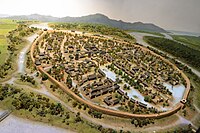Ningbo Museum
| Coordinates | 29°49′02″N 121°32′28″E / 29.817336°N 121.541178°E |
|---|---|
| Website | www |
| Ningbo Museum | |||
|---|---|---|---|
| Traditional Chinese | 寧波博物館 | ||
| Simplified Chinese | 宁波博物馆 | ||
| |||
The Ningbo Museum (
Architecture

Ningbo Museum was designed by
Materials
Materiality, or the materials used to construct a building, is a major aspect of the design and construction of the History Museum, as emphasized by Wang Shu. After a period of rapid growth in the wake of the Treaty of Nanjing, many traditional buildings were demolished in order to create space for new construction. In Wang Shu’s design process, he was dedicated to using sustainable practice and materials.
After collecting stones and bricks from demolished structures in the surrounding area, the architect gave the builders some freedom in arranging these to create walls, using the wapan technique. This involves piecing together mismatched pieces of stone or tile with thin layers of lime (similar to concrete), creating a strong but flexible connection between individual pieces. This practice was used historically to rebuild villages after typhoons swept through the region. Wang Shu was adamant on using this building technique as it maintains the practice of traditional Chinese construction, recalling the history of his and the project’s home.[1]
Other walls are decorated with cement-covered bamboos.

Design
The entire structure of the museum is broken into a few separate pieces that are connected via the central courtyard. The first three levels create a united square, housing the main entrances and administrative offices. Galleries are housed on the upper levels.
These upper levels fracture, like the mountains near the site, breaking into five smaller sections of sharp geometric shapes. The effect is created through a series of staircases and courtyards that create many different paths through the museum.[5] This cracking effect can be seen in the plan from the bird’s eye view, and the angles at which each piece jut out from the main levels creates an abstract sculptural effect on the rooftop walkways.
Public Reception
Ningbo Museum won the Lu Ban Prize in 2009, the top architecture prize in China.[6]
There was some criticism of the architect and his choice to use hundred year old materials for new construction. Opponents of using these materials noted that the town of Ningbo was moving towards a more modern aesthetic, and that this museum would keep them in the past. Ultimately, many visitors noted that the materials created a connection between the new museum and the history of the region, reflecting the interior purpose of this historical museum.[7]
Permanent exhibits
Ningbo history exhibit

Located on the second floor of the museum, this is the main exhibit of the museum, showing the history of Ningbo from the
Ningbo custom exhibit

This exhibit is located on the third floor of the museum. Wax models and mock buildings and modern electronic techniques are used to show a traditional commercial street in Ningbo. Intangible cultural heritages of the city are also on display.[9]
Bamboo art exhibit
This exhibit is located on the third floor of the museum, displaying old bamboo artefacts donated by Qin Bingnian, the son of the collector, Qin Kangxiang.[10]
Li Yuan Photography Arts Museum
The Li Yuan Photography Arts Museum, also designed by Wang Shu using materials similar to the main Ningbo Museum, opened on September 28, 2013 as a separate pavilion of 1,000 square meters space primarily used for temporary photography exhibits. It is located in the Wu San Fang on the north gate of Luzhou Park. and is named after Chinese photographer Li Yuan who was born in Ningbo.[11]
References
- ^ Golden, Elizabeth (2012). "Traditional Materials Optimmized for the Twenty-First Century" (PDF).
- ^ 宁波有了自己真正的博物馆 (Ningbo owns an authentic museum)
- ^ 宁波博物馆 废旧材料建 (Ningbo Museum: made by used materials)
- ^ 世博宁波案例馆昨揭“盖头” Archived 2016-03-04 at the Wayback Machine (Ningbo Pavilion in Shanghai Expo opened yesterday), cnnb.com.cn, [2010-03-16]
- ^ "Ningbo Historic Museum", Museum Buildings, DETAIL, pp. 278–283, 2016-12-31, retrieved 2024-02-22
- ^ 宁波博物馆获本年度“鲁班奖” (Ningbo Museum won Lu Ban Prize this year)
- .
- ^ 东方“神舟”——宁波“海上丝路”主题展综述 (City as an Eastern Boat - Theme display of ancient Ningbo as an important node in oceanic silk road)
- ^ “阿拉”老宁波 ——宁波民俗风物陈列 Archived 2013-12-03 at the Wayback Machine (Ala Ningbo residents - Theme display of Ningbo custom and culture)
- ^ 竹刻艺术——秦秉年先生捐赠竹刻珍品展 Archived 2013-12-03 at the Wayback Machine (Bamboo Art - Display of bamboo artefacts donated by Qin Bingnian)
- ^ 摄影家李元摄影艺术馆在鄞州公园内开馆(组图) (Li Yuan Photography Art Museum opens in Zhangzhou Park)
